Read Part 1 on defining distributed maritime operations.
Read Part 2 on anti-ship firepower and U.S. shortfalls.
Read Part 3 on assembling massed fires and modern fleet tactics.
Read Part 4 on weapons depletion and last-ditch salvo dynamics.
Read Part 5 on salvo patterns and maximizing volume of fire.
Read Part 6 on platform advantages and combined arms roles.
By Dmitry Filipoff
Introduction
The aircraft carrier has been the main striking arm of the U.S. Navy for decades, but distributed warfighting demands something new. Anti-ship missile firepower is proliferating across the force structure of both friendly and competitor forces, creating larger demands for the tactical information required to leverage these long-range weapons. Massed fires heavily depend on information to work, and air superiority is a powerful enabler of information superiority. By focusing on a set of critical information functions and fleet air defense, the aircraft carrier can serve as a powerful enabler and force multiplier for distributed fleets and massed fires. These roles foreshadow how nations who engage in naval salvo warfare without naval aviation will be at a sore disadvantage.
Scouting and Cueing Fires
The ocean is vast and busy, presenting a complicated battlespace to make sense of. Sweeps across large ocean areas teeming with commercial shipping can precede anti-ship strikes as targets must be found and quality targeting information developed. As Captain Wayne Hughes emphasized in his classic work Fleet Tactics, “At sea better scouting – more than maneuver, as much as weapon range, and oftentimes as much as anything else – has determined who would attack not merely effectively, but who would attack decisively first.”1
The horizon not only constrains the ability of warships to defend themselves, it makes them almost completely dependent on outside sources of information to target their long-range anti-ship fires. Warships must be well-supported by other forces that can provide the awareness that allows those warships to accurately launch anti-ship fires to long ranges.
Aviation’s speed, range, and maneuverability makes it an ideal asset for scouting large swaths of ocean, discriminating targets among maritime traffic, and cueing anti-ship fires. Aviation is also useful for denying this information to an adversary, such as through counter-scouting missions that target aerial scouts well before they could sense and cue fires. By comparison if warships are forced to emit to defeat an aerial scout, then they may have abetted the scout in its mission. By screening a naval force, aviation can serve as both the eyes and the cloak that help naval forces fire effectively first.
One of aviation’s most critical advantages in executing these roles is the realm of three-dimensional aerial maneuver. Through speed and maneuver, aircraft can more effectively manage the risks of emitting compared to surface warships. By being able to dip below the radar horizon of target warships when threatened, aircraft can manage their signatures and detectability more dynamically than warships. By shadowing naval contacts at standoff ranges and using maneuver to change the bearing to the contact multiple times over, aircraft can repeatedly stimulate emissions from contacts and use passive sensing to localize and classify targets.2
Since warship radar emissions can travel much further than the anti-air weapons these emissions can guide, aviation has an added margin of security when scouting with passive detection and shadowing warships.3 If aircraft do find themselves within range of naval air defense weapons, their ability to quickly drop thousands of feet of altitude can spoil semi-active targeting and air defense kill chains by diving below radar horizons. The ability of aircraft to use these kinds of maneuvers to preserve survivability while scouting can allow them to earn valuable proximity to warship contacts. This proximity is valuable for stimulating or observing adversary behavior with an eye toward mitigating deception and discovering decoys. By simply scouting or shadowing a warship, an aircraft could stimulate behavior because an aircraft could be interpreted as a harbinger of incoming mass fires.
These attributes allow naval aviation to be at the forefront of finding and classifying targets, cueing anti-ship fires against these targets, and giving prompt notification to friendly forces if those targets have discharged last-ditch fires. Through its superior ability to gain information and mitigate the risks of emitting, naval aviation is uniquely situated to act as quarterback to the broader distributed force.
Retargeting and Reinforcing Mass Fires
Combining missile firepower over a target is an extraordinarily time sensitive tactic. Salvos must cross over the radar horizon of a target within a narrow timeframe to reap the efficiencies of overwhelming fires, rather than have salvos risk defeat in detail. But there will be challenges in coordinating precisely-timed fires across a variety of launch platforms that are hundreds and even thousands of miles apart. Tactics and operations that heavily depend on exquisitely coordinated timing are fragile by nature. This fragility encourages militaries to build redundancy and resilience into their kill chains so they may confidently combine missile firepower from across distributed forces.
A commander could mass fires by precisely positioning distributed launch platforms and then precisely sequencing their fires. However, this is a platform-centric approach to missile aggregation. It limits the flexibility of the individual platforms to adapt to their local tactical circumstances, especially those that would encourage a platform to launch its contributing fires at a different time than what the original firing sequence planned for. The operational availability and behavior of individual force concentrations will be influenced by much more than simply being on call for contributing fires.
Platforms can be afforded more local operational flexibility when their contributing fires can be maneuvered into place after launch, rather than requiring that ideal conditions be met before launch. Firing sequences will be less susceptible to disruption if individual contributors of fires cannot launch on time yet their fires can still be made to fit into an active firing sequence.
This makes in-flight retargeting a fundamental enabler of mass fires, where retargeting adds critical dimensions of resilience and flexibility. As salvos are fired from across distributed forces, retargeting will give commanders the ability to adjust salvo flight paths and maneuvering during an active firing sequence. Rather than depend heavily on establishing highly specific platform positioning and weapon programming before launch, retargeting can give commanders more flexibility to combine and maneuver fires after launch. Retargeting critically preserves the capability to give weapons waypoints after they have been fired, offering commanders greater opportunity to maneuver weapons into combined salvos and leverage waypointing tactics during a firing sequence. Retargeting helps compensate for irregularities and disruptions in the firing sequence, offering individual launch platforms more local flexibility and the overall firing sequence more resilience. Retargeting prevents firing sequences from being locked into place once initiated, preserving a commander’s options for real-time adaptation.
The scope of retargeting’s ability to combine and maneuver in-flight fires is limited by the same factors that define a weapon’s aggregation potential, such as range, maneuverability, and flight times. The amount of opportunity to retarget and maneuver salvos of 1,000-mile range Maritime Strike Tomahawks is far greater than that of missiles with only a few hundred miles of range or a ballistic missile that can hardly deviate from its trajectory.
A longer flight time will also increase the need for retargeting, given how the longer a missile flies, the further its target may have traveled, the more defensive deception capabilities may have been deployed, and the more the overall operational situation may have changed. A subsonic missile launched at very long range, such as an anti-ship Tomahawk, could require more in-flight retargeting to find its target compared to faster or shorter-ranged missiles.
Retargeting can be especially valuable for when targets prove to be decoys, false contacts, or more heavily defended than expected. It can also help salvos remain viable even if they have suffered attrition. If a portion of contributing fires is shot down on the way to the target and it seems the remaining fires can no longer reach overwhelming dimensions, they could be redirected toward a new target that is more feasible to attack. Retargeting can help ensure that valuable missile inventory is not wasted against unfavorable targets and that fresh developments can quickly translate into revised priorities for a firing sequence.
Missiles can certainly have their own onboard retargeting capabilities and employ them together within a salvo.4 But these capabilities are heavily limited by the relatively short range of their seekers and local networks, as well as the need to maintain sea-skimming flight to maximize surprise. It is also unlikely different missile salvos can effectively communicate when separated by hundreds of miles and when flying at low altitudes. Intra-salvo retargeting is more feasible for the organic capabilities of missiles compared to inter-salvo retargeting across a wider area. The ability to communicate between separate salvos may improve once contributing fires come closer to one another near their terminal approach, but that offers relatively little opportunity to make updates for most of the firing sequence.
Using outside assets for retargeting support broadens the opportunity to make earlier updates and corrections to contributing fires. Instead of having a salvo burn through plenty of fuel only to discover poor target selection at the very end of the engagement, outside retargeting allows corrections to be made much earlier in the firing sequence, preserving range and options. If missiles do not have outside assets to update their targeting information during the firing sequence, the missiles’ autonomous programming may encourage them to increase altitude and expose themselves to defensive fires in a bid to gain the information. Outside retargeting can minimize the need for attacking missiles to break from sea-skimming flight profiles, improving their survivability and preserving the element of surprise.
A critical question is who or what can best provide outside retargeting support to salvos. By virtue of speed, maneuverability, and range naval aviation will be especially well-positioned to facilitate the combining of individual salvos into aggregated fires through retargeting. Whether through covering vast ocean areas or by focusing on the airspace around a specific target, naval aviation will be able to work datalinks to combine missile firepower into overwhelming effects.
Assessing the Illusive Offensive-Defensive Balance
As soon as high-end naval conflict breaks out, naval commanders need to prioritize their understanding of the offensive-defensive balance of naval missile exchanges. This remains one of the great unknowns of modern naval warfare that would be uncovered by real combat, of how exactly large volumes of offensive and defensive fires interact and overwhelm one another. Commanders need to know whether their salvos struck the target, how well their missiles withstood countermeasures, and how opposing air defenses performed. As missiles rain down upon warships, collecting data on the effectiveness of a variety of defensive capabilities will constitute an especially critical line of effort for wartime adaptation. Developing a more precise understanding of the offensive-defensive balance is fundamental to optimizing volume of fire, managing munitions inventory, and identifying crucial areas of competitive advantage. In this vein, battle damage assessment and investigating air defense performance are fundamental to securing an edge in modern naval warfighting.
In a form of warfare where dozens of missiles could be needed to break through a warship’s defenses, but only a single hit is necessary to earn a kill, the potential for wasteful overkill is tremendous. If the offensive-defensive balance of a naval salvo engagement tilts even slightly toward the offense, it could take the form of numerous missiles wastefully crashing into a warship that was already long gone after the first hit. But commanders that attempt to precisely optimize the volume of fire to minimize overkill are more likely to risk having their salvos be defeated wholesale. Rather, securing information on salvo effectiveness would be more about understanding the margin of overkill and how much overkill can be reasonably afforded and tolerated, rather than attempting to minimize it entirely.
Commanders would clearly want to know if their salvos were shot down. If they are to organize another attack, they would benefit greatly from estimates of what proportion of the attacking missiles were downed by what types of defenses, and how many air defense missiles were expended by the defenders. These factors can help determine how much volume of fire would be needed in follow-on attacks and what types of offensive weapons may perform better. If targets were destroyed, commanders would still benefit greatly from knowing air defense performance for the sake of optimizing future volumes of fire.
But the ability to assess the effectiveness of missile firepower can be severely challenged by the great distances anti-ship missiles must travel and how targets may be fired upon near the limits of scouting capabilities. Commanders may not immediately know whether their targets were destroyed or if their salvos were shot down without landing hits. The uncertainty surrounding the results of long-range missile exchanges can prolong and complicate the decision-cycle and threaten to yield information advantage to the defender, who will often be in a much better position to assess the battle damage, weapons depletion, and defensive performance of their own forces after being attacked.
Naval aviation can earn the valuable proximity to targets to help gather this critical information. By shadowing naval targets, naval aviation can witness hostile air defenses in action and view how missile exchanges play out. Aviation could help commanders understand the offensive and defensive volume of fire being discharged from adversary warships, and the specific composition of that volume of fire. This can enhance a commander’s understanding of the adversary’s weapons expenditures, how they are assembling massed fires, and their own competing perceptions of the offensive-defensive balance.
This information will be critical for manipulating one of the major levers navies have for adapting the force in the midst of conflict, which is the composition of payloads within platform magazines. By taking a “payloads not platforms” approach, navies can maintain an edge in real-time conflict by flexing missile loadouts in reaction to fresh data on salvo effectiveness and adversary air defense performance. If adversary air defenses prove poor, a navy could afford to bolster its own air defenses by increasing the share of magazine space allocated to such capabilities. Or it could capitalize on the adversary’s disadvantage by filling more magazine space with anti-ship weapons, or with the specific types of weapons that are proving to be more effective.
This information will also be vital in knowing what kinds of salvos and volumes of fire do or do not warrant last-ditch salvos. A more precise understanding of the offensive-defensive balance means less inventory will be lost to last-ditch pressures as commanders have a clearer understanding of what warrants a last-ditch salvo. On the flipside, if it does not take much volume of fire to cause the adversary to discharge last-ditch salvos, then that would be critical to know and exploit.
Understanding the offensive-defensive balance is especially critical given the potentially decisive role of defensive systems with limitless magazines. Although they mainly function at close range, capabilities such as electronic warfare, high-power microwaves, laser dazzlers, and other softkill measures could provide an enduring measure of defense. This could prove critical for keeping warships in the fight even if they are running low on hardkill defenses. Softkill capabilities could also substantially change the nature of modern naval combat more generally. As Capt. Tom Shugart (ret.) points out:
“the consequences of the interplay of jammer versus seeker, sensor versus signature, and hacker versus data stream are likely to propagate from the tactical to the operational and perhaps strategic level in ways not seen before. As one specific and obvious example, a conflict where China’s [anti-ship ballistic missiles] could be consistently made to miss through the use of jammers might be a completely different war than one where that was not the case.”5 [Emphasis added]
This has happened before. The first ever wartime naval missile exchanges highlighted the decisive potential of softkill systems. The naval missile combat of the Arab-Israeli 1973 war took the form of Israeli missile boats successful sinking opposing missile boats despite those adversaries fielding longer-ranged missiles. Israeli electronic warfare was completely successful in jamming every anti-ship missile that was fired at their warships, allowing them to close the distance and destroy their opponents. While these engagements occurred in relatively confined waters between small combatants, Israeli success was likely not possible without extraordinarily successful electronic warfare defenses, and the failure of Arab forces to understand why their missiles kept missing.6 If aviation can gather data on enemy softkill performance in missile exchanges, it may offer a useful view into some of the more decisive factors shaping the offensive-defensive balance.
Air Defense and Shooting Archers
Aside from critical information functions, there is a vital kinetic role for naval aviation to play. Naval aviation will be sorely needed to preserve the survivability of the broader surface fleet. This dependency is best illustrated through the severe tactical challenges surface warships face in defending themselves against missile salvos.
The immutable obstacle posed by the curvature of the earth severely constricts the amount of space and time in which warships can defeat sea-skimming missiles, despite their dense defenses. Sea-skimming flight takes advantage of the radar horizon limitations of defending warships, leaving them with little choice but to engage incoming missiles at a very short distance away from the ship (typically around 20 nautical miles) and with only tens of seconds before impact.7
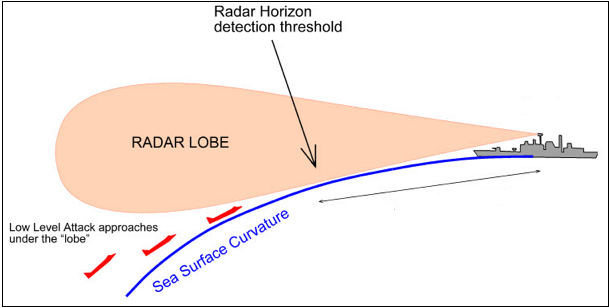
In a fierce bid for survival, warships will engage a variety of defensive weapons and systems simultaneously to wipe out incoming salvos bearing down on the ship. But the defending warship will be suffering a major disadvantage given how the totality of the attacking volume of fire is already in flight and closing in, but the defending volume of fire has to be built from scratch and achieve significant mass in a matter of seconds. Not all defending missiles can be fired simultaneously, while the attacking missiles can organize into a saturation pattern where they can all strike simultaneously. Even with a very high rate of fire, the defending missiles will be naturally bottlenecked into a narrow stream salvo pattern which may not achieve sufficient volume of fire. Even firing one defensive missile per second may not be fast enough when an attacking supersonic salvo is roughly only 50 seconds away from impact after it breaks over the horizon.
A supersonic salvo could already be about halfway across the 20 or so miles it is visible to the ship by the time the first intercept occurs.8 If a warship is employing the U.S. Navy’s shoot-shoot-look-shoot doctrine, it may only have enough time to fire off a single salvo per threat from its primary defensive armament before this capability is negated by the incoming missiles getting inside the minimum engagement range of defenses. As inbound salvos close the distance, vertically hot-launched defensive missiles will struggle to rapidly reorient for steep downward intercepts, narrowing the amount of defensive firepower available from the missiles in dozens of launch cells to the relatively few munitions of close-in systems that are able to fire on flatter angles. This challenge will be even more severe when saturation salvos aim to get all missiles inside the defender’s minimum engagement range at the same time. In the terminal phase the attacking missiles also enjoy the benefit of traveling at their maximum speed, unlike many of the defending missiles launching from a short distance away. The closer the attacking missiles get to the ship, the less time the defending missiles have to accelerate to higher speeds, further reducing the distance at which they can make intercepts. Because of these factors, even if a warship has a large magazine, a ship may not be able to fully leverage its magazine depth for defense before the first missile strikes the warship.
And missiles may not even need to strike the ship to score a mission kill. As defensive missiles clash with incoming weapons at closer and closer ranges, powerful warheads will be detonating against each other near the ship and at closing velocities of thousands of miles per hour. Exploding missile shrapnel will spray out, easily shredding exposed radar arrays, close-in weapon systems, and electronic warfare suites, systems that are all critical to a warship’s last line of defense.
 An SM-6 anti-air missile intercepts a relatively small, 600lb AQM-37C test missile. Note the shrapnel. (Source: U.S. Missile Defense Agency Multi-Mission Warfare Flight Test Events)
An SM-6 anti-air missile intercepts a relatively small, 600lb AQM-37C test missile. Note the shrapnel. (Source: U.S. Missile Defense Agency Multi-Mission Warfare Flight Test Events)
As automated combat systems and pre-programmed responses come online and take over these complex engagements, Sailors may have little direct control in those final seconds as enormous volumes of automated firepower attack and defend the warship.
Surface warships should be spared the burden of these harrowing missile engagements as much as possible. This will require shooting down archers instead of arrows and being able to destroy missiles that are traveling beneath the radar horizons of their target warships. But shooting down aerial archers will prove especially challenging because the substantial range advantage anti-ship missiles often have over anti-air weapons converts into a greater ability for aerial attackers to fire first. This range advantage also allows attackers to more easily exploit the radar horizon to turn their standoff fires into lethal close-in engagements for defenders.
These factors make airpower indispensable to missile defense because many anti-ship weapons intentionally fly below the radar horizon of warships in spaces only aircraft can see from above. The speed and altitude of aircraft will give them much more opportunity to shoot down sea-skimming missiles compared to warships. Anti-ship missiles also pose no threat to aircraft, allowing for heavily one-sided exchanges. Aircraft can safely and substantially reduce the volume of anti-ship missile firepower bearing down on friendly warships, and potentially even use jamming to attrit incoming salvos with softkill effects. Aircraft can also organize into horizontal formations that launch anti-air weapons in saturation patterns, perhaps making them the only naval platform capable of launching defensive fires in this salvo pattern at scale.
 A squadron of F-14 Tomcats arrayed in a horizontal formation launches multiple waves of anti-air missiles in saturation patterns. (Source “Red Storm Rising: Chapter 20 The Dance Of The Vampires (FINAL CUT)” by FIXEDIT via Youtube, generated with Digital Combat Simulator World.)
A squadron of F-14 Tomcats arrayed in a horizontal formation launches multiple waves of anti-air missiles in saturation patterns. (Source “Red Storm Rising: Chapter 20 The Dance Of The Vampires (FINAL CUT)” by FIXEDIT via Youtube, generated with Digital Combat Simulator World.)
Aircraft can use speed and maneuver to provide flexible and on-demand air defense support to distributed forces. A commander can dynamically reposition aircraft based on emerging threats and incoming salvos to bolster air defense capability where it may be needed most. While aircraft may be hard-pressed to reposition in time to intercept missiles with a low time-to-target, they can pose a much more serious threat to missile salvos that can take longer to reach their target, especially the Tomahawk.
These anti-air roles are much more favorable to the air wing in a variety of ways, but especially in terms of volume of fire. Because of the limits of hardpoints and airframes, many multirole aircraft can fire a larger number of anti-air missiles than anti-ship missiles. A fully loaded F/A-18 can carry 12 anti-air missiles compared to only four anti-ship missiles, allowing the aircraft to shoot down more anti-ship weapons than it could fire itself.9 24 F-18s would be required to match the number of anti-ship missiles fielded by a single American destroyer if its launch cells are fully loaded with anti-ship Tomahawks, but only eight aircraft are needed to match a destroyer fully loaded with anti-air Standard Missiles.10 A handful of aircraft can therefore be enough to substantially tilt the balance of a naval salvo engagement in favor of the defending warships.
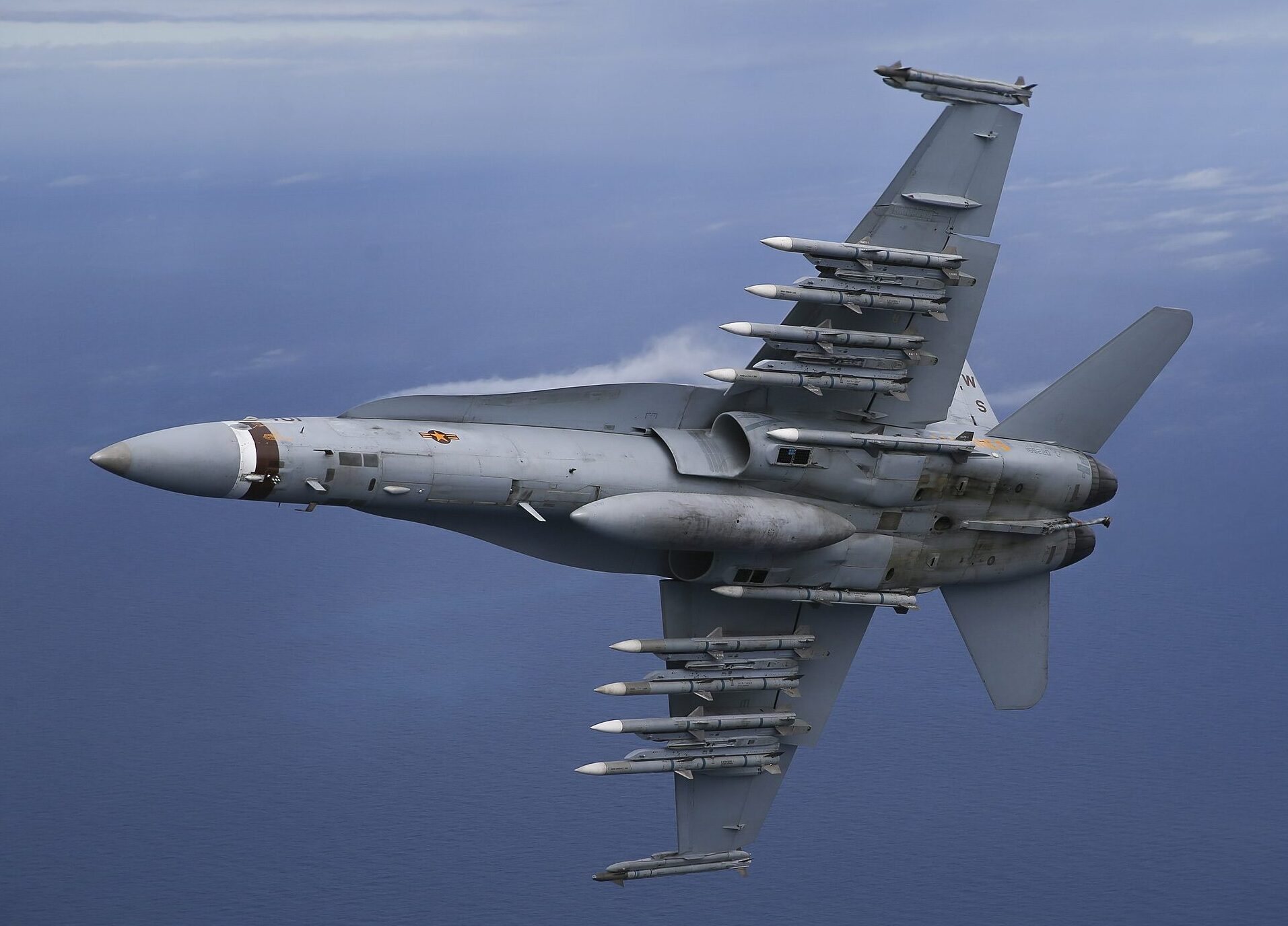
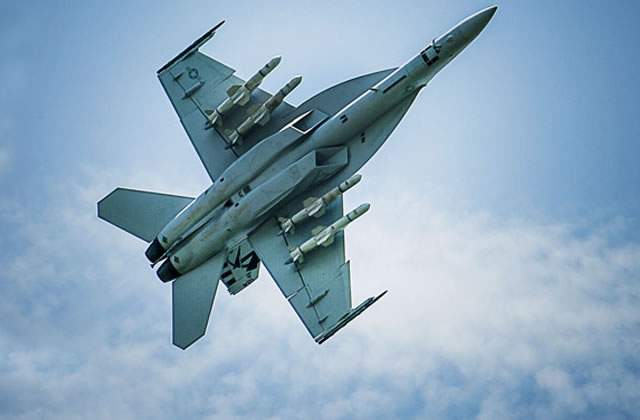
By virtue of having an overheard view, the anti-air weapons fielded by aircraft can be much more effective at shooting down cruise missiles than the much larger shipboard anti-air weapons. A shipboard anti-air engagement can be spoiled by simply having targets dive below the radar horizon of the illuminating warship, where the radar horizon constraint substantially diminishes the range advantage of the larger anti-air missiles that can be fielded via a ship’s launch cells. It is debatable how useful that extra range is for the larger ship-based air defense weapons when so many of these weapons’ dependence on semi-active illumination makes their killchains much more easily disrupted by target maneuvering.
Allowing aviation to pick up more of the air defense mission will allow warships to fill more of their launch cells with offensive weapons, where the added missile size and range is much more useful for a warship’s offensive fires than defensive ones, save for perhaps defending against aircraft or especially high-end threats like ballistic missiles. Aircraft can also reload their anti-air weapons in a fraction of the time it would take warships to do the same, contributing to a more sustainable warship presence. Aircraft will also be critical for providing warships with early warning of incoming salvos, and helping them determine whether and when those warships should launch last-ditch fires.
Aviation is also needed to work the Navy’s NIFC-CA capability (Naval Integrated Fire Control-Counter Air). This allows a warship to fire at targets beneath its radar horizon, if an aerial intermediary can facilitate the engagement.11 This capability helps extend the anti-air battlespace and adds depth to a warship’s ability to defend itself. Extending the anti-air battlespace can also help preserve inventory since the pressure to fire more interceptors per incoming missile increases the closer the salvo gets to striking the warship. But these NIFC-CA capabilities and advantages are dependent on aviation to function.
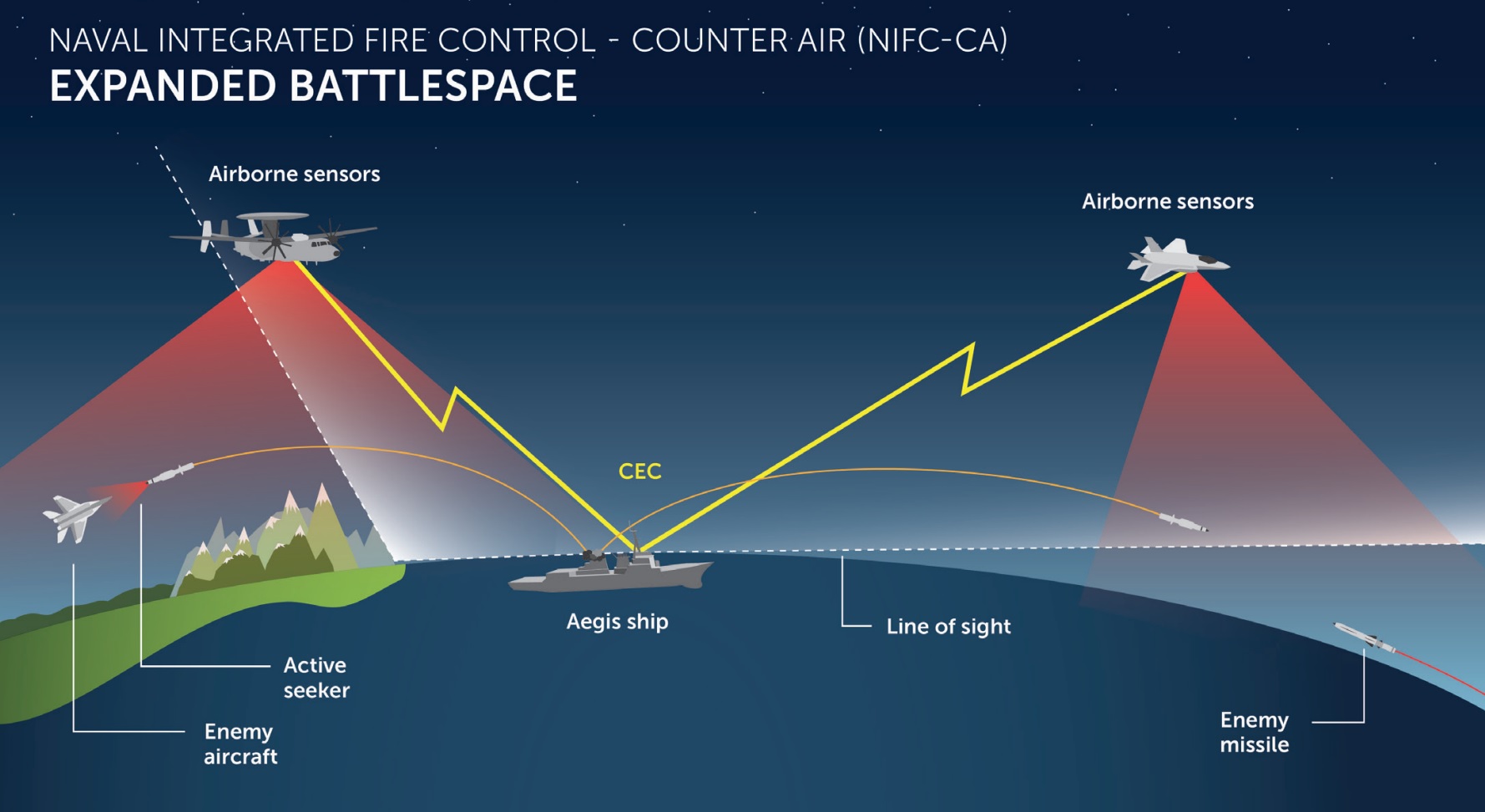
A common benefit throughout these various methods of applying airpower to anti-ship missile defense is that they substantially extend and complicate the air defense battlespace. This is critical toward increasing the attacker’s challenge in a type of engagement where defending warships suffer significant disadvantage. Regardless of how powerful and capable a warship is, the burden of attacking a warship is substantially lessened by how the radar horizon forces defensive engagements to begin only mere miles away from the ship. Using aviation to extend the air defense battlespace far beyond a warship’s horizon will greatly lengthen the gauntlet missiles must run to hit their targets. If attackers suspect that flexible airpower can be brought to bear on their salvos long before those missiles get near their targets, then they may have to consider expending much larger volumes of fire or reconsider the engagement entirely. They may also have to consider more complex tactics in sequencing and waypointing their fires to stretch defensive aviation thin or pull it away in directions that create opportunities for salvos to break through to targets.
This type of air defense coverage can go both ways. An adversary may also deploy aircraft to diminish the volume of fire to help protect their warships. This creates a strong incentive to provide air defense coverage to friendly salvos on their way to the target, since warships can hardly provide such coverage to their own attacking salvos. If a warship wanted to provide air defense coverage to its own offensive salvos, then it would have to substantially close the distance so its air defense firepower can overlap the range its anti-ship firepower has to travel to the target. But this is unrealistic in many contexts, and would sacrifice much of the anti-ship weapons’ range. And it would still be of little use against aircraft that can still dip below a ship’s radar horizon and engage the ship’s attacking salvo without fear of shipboard air defenses. Aircraft will therefore be needed to not only attack incoming salvos below the radar horizon, but to engage opposing aircraft that are looking to do the same on behalf of their own warships.
Warships can play a longer-range air defense role in this specific fight, when aircraft are dogfighting near the warship in a bid to protect or attack a salvo that is closing in. Aircraft that look to escort attacking salvos may have to contend with defending aircraft whose tactics can force the escorts to maneuver within view of the target warship’s air defense capability. Those maneuvering aircraft could be more targetable at longer ranges for warships than the salvo that is traveling at a more fixed sea-skimming altitude. This can allow a warship to threaten the salvo’s escorting aircraft, which then frees friendly aircraft to focus more on attriting the salvo on behalf of the warship. If there are a significant number of aircraft escorting a salvo, then defending aircraft could pull behind the air defense screen of the warship to enhance survivability, while still being in a position to attrit the salvo, although with perhaps less opportunity to do so than a more forward disposition. If substantial opposing aircraft are encountered, friendly aircraft can fall back upon the air defense screens of the surface warships, and leverage combined arms tactics to fight back against the attacking salvos and their escorting aircraft.
Naval aviation is also critical for defending against bombers, which are one of the most flexible and lethal platforms for anti-ship attacks. Because of their long range and the size of their magazines, bombers can launch substantial volume of fire against warships at distances that are well beyond the warship’s ability to launch anti-air weapons. These features make it especially difficult to destroy archers before they can fire their arrows when it comes to bombers. Aviation is the main asset that can find and intercept bombers and impose last-ditch firing dilemmas upon them before they are able to fire upon warships.
A key challenge is how to maintain these forms of air defense coverage at a distance from a carrier. These tactics are reminiscent of the “chainsaw” tactics of the Navy’s Cold War-era Outer Air Battle concept of the 1980s. A large number of carrier aircraft would maintain a continuously cycling aerial presence well forward of the carrier battle group so they could shoot down Soviet bombers before they could launch anti-ship missiles, and where these engagements would take place between 400-500 nautical miles from the carrier.12 But this tactic was challenging to sustain in practice and could not cover all approach vectors, even when the baseline capabilities were more favorable to the U.S. Navy than what it has today. Those capabilities included a longer-ranged and specialized interceptor aircraft (the F-14 Tomcat), which fielded a longer-ranged interceptor missile (the AIM-54 Phoenix), to threaten bombers that were using shorter-ranged anti-ship missiles than what competitors field today. Under the aforementioned concept of operations for supporting distributed forces, multiple carriers would be needed to sustain multiple chainsaw-type air defense screens, and for distributed surface forces and salvos operating at a significant distance away from the carrier, while using shorter-ranged carrier aircraft against bombers that have longer-ranged anti-ship missiles compared to the Cold War. In practice, it may be infeasible to sustain multiple chainsaws out to a range where they could attack archers before they fire arrows. Instead, the air wings may have to limit their reach and allow the hostile firepower to be launched, and then attrit it to a more manageable volume for the surface warships to finish off.

Focusing much of the carrier air wing on providing air defense against bombers and sea-skimming threats will substantially enhance the survivability of both warships and aircraft. Compared to launching distant attacks against warships, defensive anti-air and interdiction roles allow aircraft to remain closer to friendly forces, fly more safely at higher altitudes, and take on anti-air loadouts that are lighter than anti-ship loadouts. Each of these factors contributes to higher endurance, sortie rate, and survivability for aircraft compared to the challenging requirements of massed long-range strikes against heavily defended targets. These missions better play to aviation’s strengths and give warships much better margins of survival against potent missile threats.
These trends also signal a clear warning to surface fleets. Surface warships should be especially cautious about traveling beyond the support of aviation, or otherwise risk being alone in facing sea-skimming salvos in harrowing close-range engagements.
Carrier Coverage Limits and Information Roles
The major information requirements of naval conflict and the risky nature of massing carrier aircraft for anti-ship strikes both point to a critical takeaway – in fleet-on-fleet combat the carrier air wing should focus more on enabling the delivery of cruise missile firepower from the broader distributed force rather than delivering it themselves. This is a more complex arrangement than the traditional Carrier Strike Group construct, where the air wing would shoulder most of the anti-ship mission. Now the carrier can be asked to provide critical enabling functions for many warships and salvos, and at substantial ranges across a distributed fleet. But while these functions are more favorable to the air wing and the broader fleet for a variety of reasons, they still have critical constraints that can limit how a distributed force can arrange itself and assemble massed fires.
When it comes to securing information, aircraft can be playing multiple overlapping roles in the contested space between opposing fleets. An aircraft retargeting a friendly anti-ship salvo could end up defending that salvo and itself from opposing aircraft looking to intercept. That aircraft could also be shooting down last-ditch fires launched by the target warship it is guiding the salvo toward, while also gathering data on the warship’s air defense performance and the composition of its volume of fire.
These air defense and information functions are highly complementary and integrative. Aircraft will be poised to clash with opposing aircraft that are performing similar information functions as both seek to enable salvos and defend against them. These intertwined functions set the stage for a hotly contested aerial battlespace between fleets as they exchange fire. Securing air superiority in this space, even temporarily, will translate into information superiority that yields significant offensive and defensive advantages.
Many of these critical missions, including scouting, counter-scouting, battle damage assessment, salvo escort, and retargeting support still require proximity to targets and can pull the carrier deeper into the battlespace. This proximity can require that aircraft and aircraft carriers operate from ranges similar to that of launching strikes, except the distances are determined more by sensor and network ranges rather than weapons range. Aircraft that are not E-2s or F-35s may need to get much closer to threats and friendly assets to earn and send this information, and potentially risk themselves against shipboard air defenses. These missions will also require proximity to friendly forces and distributed naval formations to enhance their early warning and air defenses.
The positioning of the carrier and the reach of its air wing will therefore determine the extent of information and air defense coverage it can provide for the broader distributed force and its massed fires. Similar to how weapons range can limit how far forces can distribute from one another and still combine their fires, the limits of air wing coverage can further bind the disposition of a distributed fleet. A fleet will have to limit the extent of its distribution if it is to seize the force-multiplying advantages of these combined arms relationships, while weighing the benefits of those relationships against the risks of greater force concentration.
Consider the need to overlay cruise missile range with aerial retargeting support and air defense coverage to help ensure friendly salvos are well-supported on their way to the target. Combine this with the need to keep surface warships close enough to the carrier that aircraft can interdict opposing bombers before they are within range of firing. Otherwise surface warships could be fired upon and picked off by platforms that are advantaged in firing first against warships. When these multiple combined arms relationships are factored in, the result is a fleet disposition that is considerably more concentrated than simply fielding a variety of widely separated Tomahawk shooters. These relationships and their concentrating effect on fleet disposition are depicted in Figure 1.
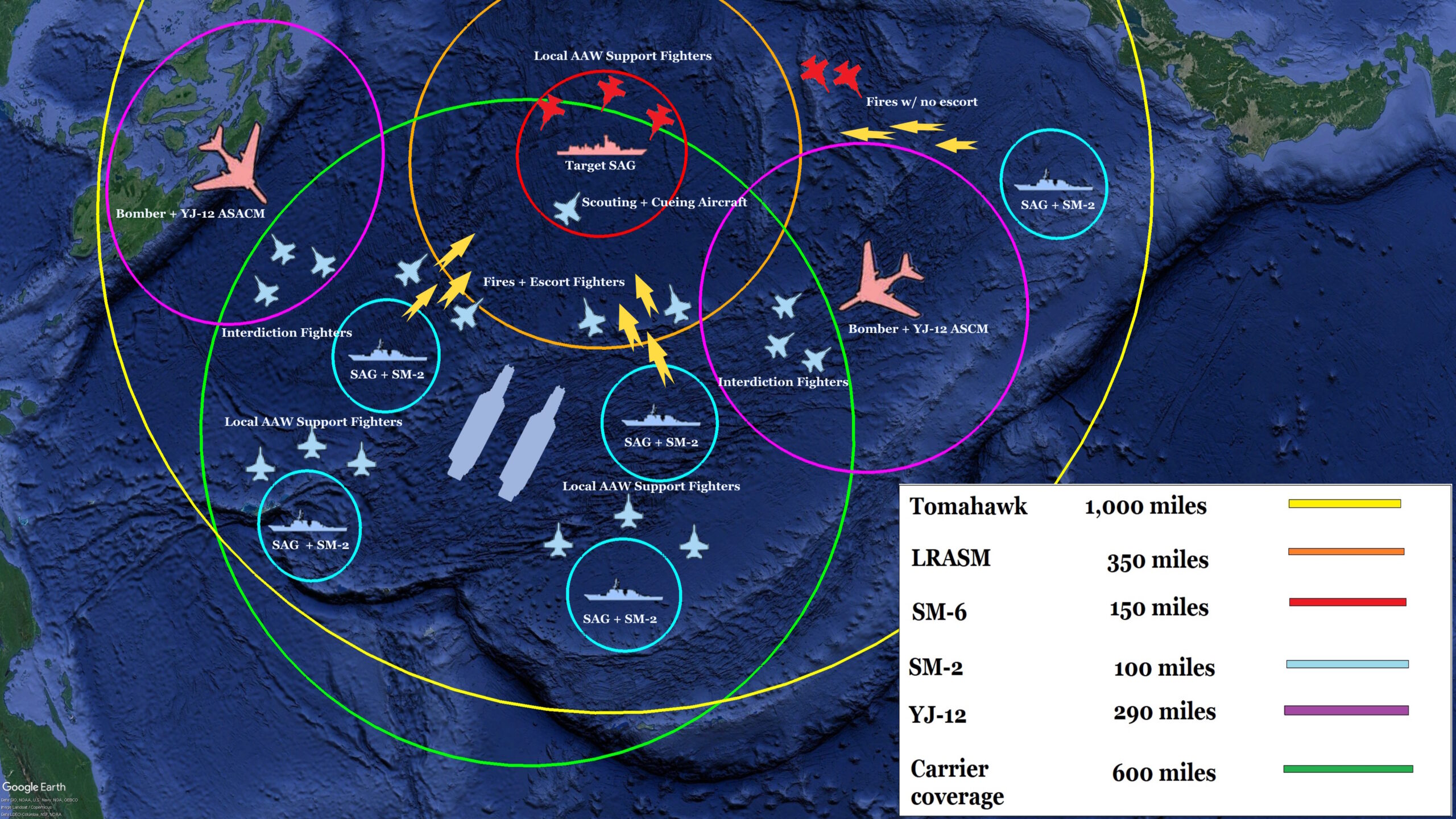
In particular, the degree of overlap between retargeting coverage and weapons range can limit the area where aggregation can be supported, and how far platforms can distribute from one another. If a carrier wants to support an extreme range Tomahawk salvo, the carrier could have to be hundreds of miles forward of the launch platforms since the missile substantially outranges the unrefueled air wing. If a carrier wants to provide similar support for a shorter-ranged Naval Strike Missile attack, the carrier could be hundreds of miles behind the launch platforms and still be available. The missiles that can widen force distribution through their longer range may have to forego critical aerial support across wide ocean areas and especially in the final phases of combining fires, because their long range can also take them well beyond the support of friendly aviation.
The air wing will be severely taxed to cover all these critical information functions across a broad battlespace. This will make it extremely difficult if not outright impossible to mass the air wing, either for concentrated attack or defense. LCDR Sandy Winnefeld noted this challenging dynamic in the Cold War:
“So many fighters are required to support scouting requirements that very few are left on deck to counter the threat once it is discovered…in a superb example of Sun Tzu’s maxim, ‘He who prepares everywhere will be weak everywhere,’ airborne fighters are so spread out that they cannot defend against a concentrated attack…Instead, airborne scouting fighters must be rapidly remarshalled to provide firepower when a [bomber] raid is detected… At realistic power projection ranges, the amount of firepower needed to counter [a mass Soviet naval bomber] raid is currently more than even a multi-carrier battle group force can realistically keep airborne continually during a campaign-length operation…the lion’s share of the killing will have to be done by deck-launched interceptors.”13
Extensive scouting and information functions will need to be performed regardless of whether the air wing is heavily concentrated for offense or defense. Those concentrated aerial formations are themselves heavily dependent on effective scouting, cueing, and in-flight updating to effectively perform at long ranges. The scouting demands of wide-area naval defense are considerable enough, especially when attempting to counter opposing scouts and bomber raids at distances that aim to preempt their firings. Adding the scouting demands of mass air wing attacks on top of baseline defensive requirements will stretch the carrier air wing even more thinly, making this combination of multiple steep requirements likely unworkable.
Even though these roles may not do much to increase the standoff distance of the carrier, an information-centric air wing is more survivable because it allows the air wing to be more distributed. Even one scouting aircraft can be enough to conduct the aforementioned information functions, from scouting a target warship at standoff ranges, cueing fires against it, retargeting those fires into an aggregated salvo, and assessing defensive performance and the result of the attack. This is far more preferable than sending masses of concentrated air wings to the limits of their range to launch risky attacks against only several warships at a time. The amount of aviation needed to sense a target and network fires against it could likely be met by far fewer aircraft compared to the numbers needed to mass the volume of fire organically through the air wing itself.
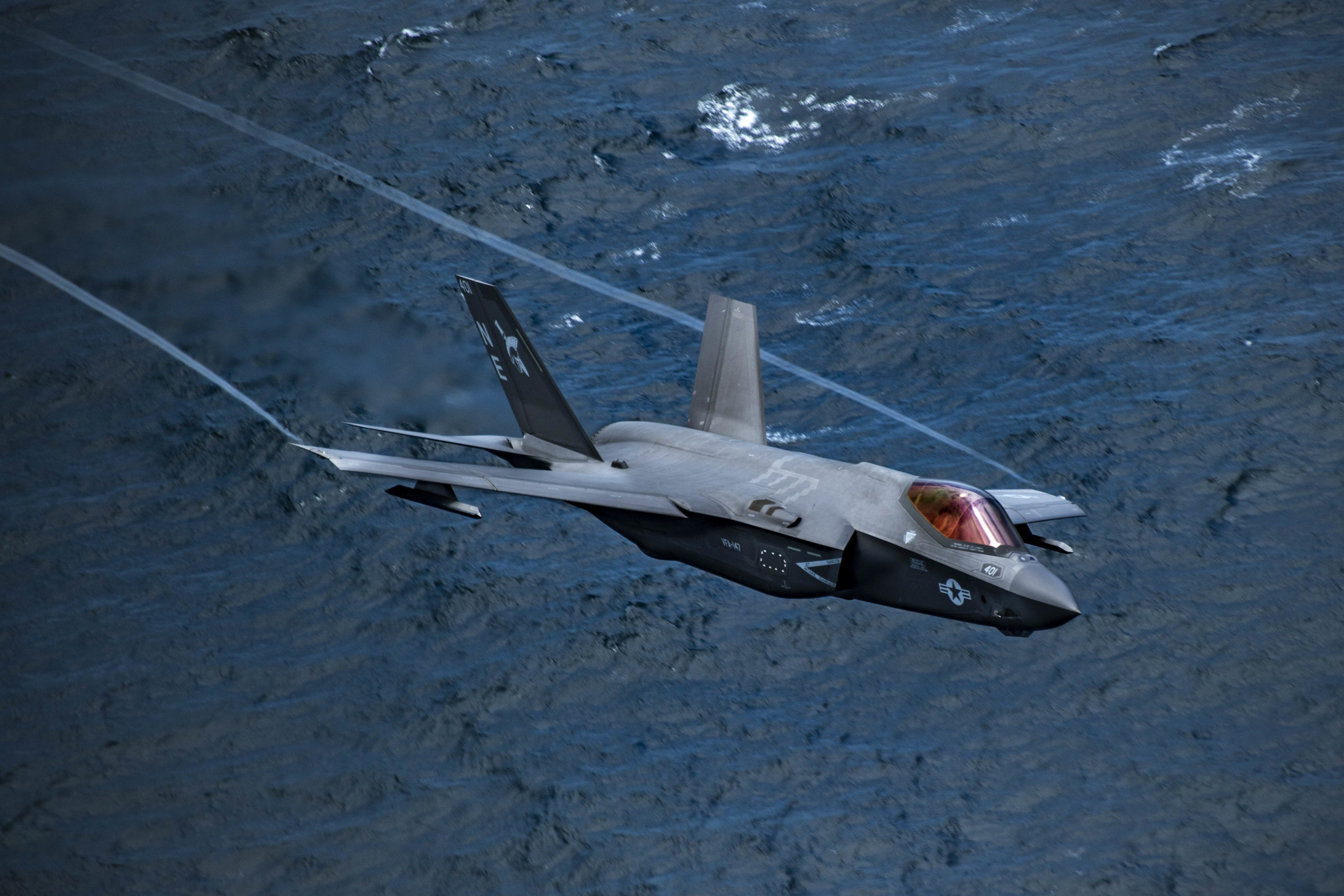
Removing much of the demand for carrier-centric strike operations will improve the survivability of the carrier. Adversaries may not choose to fire weapons near the limits of their range to engage carriers, especially long-range assets such as bombers and ballistic missiles. Instead, they may wait until the carrier is within range of its own offensive capability, knowing that the air wing may then be split between offensive and defensive missions, which lowers the volume of fire required to achieve overwhelming effect. If an anti-carrier strike was launched at ranges that exceed the offensive capability of the target carrier, then the strike is more likely to have to contend with a purely defensive air wing composition. As LCDR Winnefeld noted:
“If the Soviets cooperate by attacking at extremely long ranges, U.S. battle forces will be able to fight the [bomber raids] on their own terms. Carriers will be able to enhance their survivability by orienting their flight deck configurations exclusively to [defense]… Unfortunately, the Soviets may wait…tacticians counting on defeating the [bomber forces] at long ranges may be disappointed by an adversary who is unwilling to come out and fight on the [carrier group’s] terms. Carrier battle forces will probably be required to defend themselves and project power simultaneously.”14
These information-centric missions improve carrier survivability by allowing for more aircraft and hardpoints to be devoted to early warning and defensive capability. But even with their advantages, these information-centric missions may improve the carrier’s survivability only marginally because of the enduring need to earn proximity to targets and friendly forces.
The carrier air wing does not have to be alone in executing these roles. The Maritime Patrol Aircraft community can make major contributions to battlespace awareness and communications, especially through new high-endurance drones like Triton. The land-based aircraft of the MPA community can substantially alleviate the burdens these information missions place on the air wing. However, these aircraft do not equip much in the way of anti-air weapons and are not as maneuverable as carrier multirole aircraft. Their ability to kill scouts and missiles will be extremely limited.
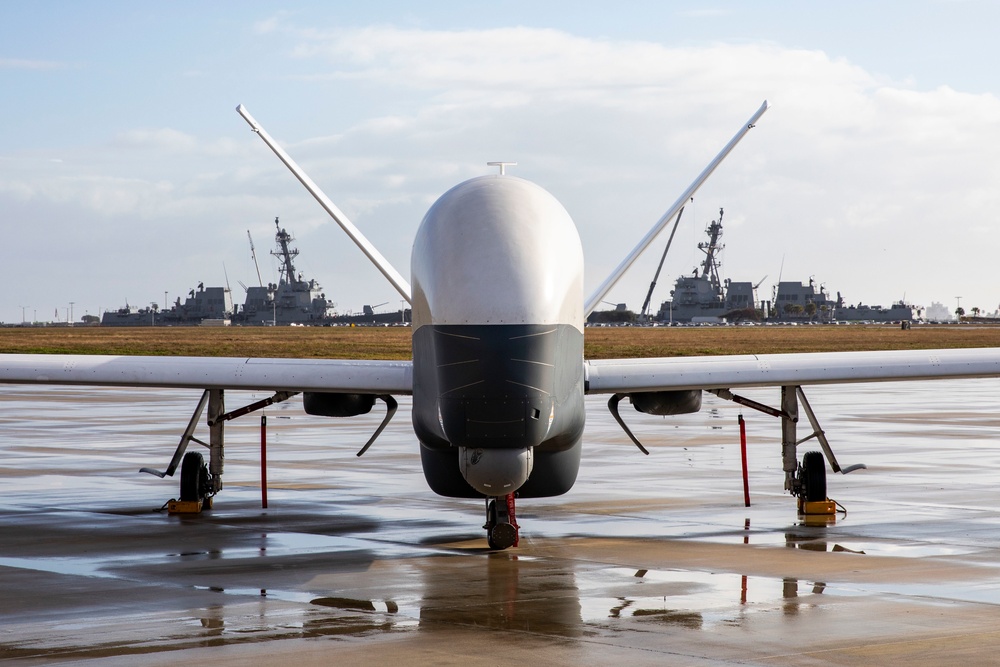
Information can of course come from other assets. The Air Force can play a major role in developing awareness of the maritime battlespace, as well as space-based assets and allied forces. What is less clear is whether the degree of network interoperability and integration is enough to supplant many of naval aviation’s information functions, rather than only supplement them.
The suggested information-centric missions are limited by what resides within the modern carrier air wing. It is unclear whether the mainstay aircraft of the Navy’s carrier air wings – the F/A-18 – has powerful enough sensors and networking ability to conduct these information operations to a highly capable degree. These aircraft often depend on information from the E-2 airborne early warning aircraft, which features long-range sensing, considerable networking capability, and extensive battle management systems. But only a handful of these aircraft are fielded in an air wing, and only recently have they begun fielding variants that are capable of in-flight refueling.15 These limitations greatly constrict the availability of the aircraft and therefore the scope of ocean space that can benefit from their information functions. The F-35, with its modern sensing and networking capabilities, may prove especially useful in executing these information-centric air wing operations. But until the F-35 is widely fielded, the Navy’s ability to reap the benefits of these information functions and harness the broader firepower of the distributed fleet will be constrained.
Conclusion
General platform attributes or mission areas are not a sufficient basis to determine the continued relevance of a platform. Ultimately in combat, a platform lives or dies by the viability of its tactics, of how its specific concepts of employment interact with a contested battlespace, and of the precise details of how it would actually be applied in warfighting. For distributed warfighting at sea, there is a clear argument to be made for the vital role of naval aviation, whether it must come from aircraft carriers or somewhere else. Some of these arguments are couched in the fact that many of the premier weapons of modern naval warfare are themselves fast airborne payloads, that warships are mostly blind to spaces of enormous tactical consequence, and that air superiority is a powerful enabler of information superiority. Navies should carefully consider these factors as they debate the future of their force structure and naval warfare.
Part 8 will focus on China’s ability to mass fires.
Dmitry Filipoff is CIMSEC’s Director of Online Content and Community Manager of its naval professional society, the Flotilla. He is the author of the “How the Fleet Forgot to Fight” series and coauthor of “Learning to Win: Using Operational Innovation to Regain the Advantage at Sea against China.” Contact him at [email protected].
References
1. Wayne P. Hughes, Jr., Fleet Tactics: Theory and Practice, pg. 173, Naval Institute Press, 1986.
2. Tyler Rogoway, “Navy’s Super Hornet Boss On The Jet’s Game-Changing Infrared Search And Track Sensor,” The War Zone, July 27, 2020, https://www.thedrive.com/the-war-zone/34966/navys-super-hornet-boss-on-the-jets-game-changing-infrared-search-and-track-sensor.
3. Wayne P. Hughes and Robert Girrier, Fleet Tactics And Naval Operations, Third Edition, pg. 188, U.S. Naval Institute Press, 2018.
4. John Keller, “Lockheed Martin to build six more LRASM anti-ship missiles with GPS/INS, infrared, and radar-homing sensors,” Military and Aerospace, March 23, 2022, https://www.militaryaerospace.com/sensors/article/14248345/multimode-sensors-antiship-missiles.
5. Thomas H. Shugart III, “Trends, Timelines, and Uncertainty: An Assessment of the Military Balance in the Indo-Pacific,” Testimony Before the Senate Foreign Relations Committee, Hearing on Advancing Effective U.S. Policy for Strategic Competition with China in the Twenty-First Century, March 17, 2021, https://s3.us-east-1.amazonaws.com/files.cnas.org/backgrounds/documents/Shugart-SFRC-Testimony-17-Mar-2021-FINAL-compressed.pdf?mtime=20210316153840&focal=none.
6. Abraham Rabinovic, The Boats of Cherbourg: The Navy That Stole Its Own Boats and Revolutionized Naval Warfare, revised edition, independently published, 2019.
7. Lee O. Upton and Lewis A. Thurman, “Radars for the Detection and Tracking of Cruise Missiles,” Lincoln Laboratory Journal, Volume 12, Number 2, pg. 365, 2000, https://archive.ll.mit.edu/publications/journal/pdf/vol12_no2/12_2detectcruisemissile.pdf.
8. This estimate is based on the attacking anti-ship missiles traveling at a speed of Mach 2.5, or roughly 32 miles per minute, and the missile taking up to around 10 seconds to accelerate from subsonic speed to its terminal sprint after breaking over a target warship’s horizon. China’s YJ-12 and YJ-18 anti-ship missiles have terminal sprint capability up to Mach 2.5. The Mach 3 speed of the U.S. Navy’s SM-2 anti-air missile amounts to about 38 miles per minute. These two speeds taken in combination amount to the missiles meeting at roughly the halfway point of a 20-mile-long engagement space going from the horizon to the target warship.
9. Dr. Carlo Kopp, “Flying the F/A-18F Super Hornet,” Air Power Australia, originally published May/June 2001 in Australian Aviation, https://www.ausairpower.net/SuperBug.html.
10. A U.S. Arleigh Burke-class destroyer has 96 vertical launch cells. The estimates of matching of missile capability focuses on number of missiles, not their specific dimensions, and excludes deck-mounted missiles and weapons fielded within the magazines of turreted point defense launchers.
11. Wes Rumbaugh and Tom Karako, “Extending the Horizon: Elevated Sensors for Targeting and Missile Defense,” Center for Strategic and International Studies, September 2021, https://csis-website-prod.s3.amazonaws.com/s3fs-public/publication/210927_Rumbaugh_Extending_Horizon.pdf?VersionId=4A_Sv5v1HuR5cghHC1proU6iJ1m2gjx1.
12. For Outer Air Battle and Chainsaw concept, see:
Andrew F. Krepinevich, Maritime Warfare in a Mature Precision-Strike Regime, Center for Strategic Budgetary Assessments, pg. 50-52, 2014, https://www.files.ethz.ch/isn/190270/MMPSR-Web.pdf.
Thomas P. Ehrhard, PhD and Robert O. Work, Range, Persistence, Stealth, and Networking: The Case for a Carrier-Based Unmanned Combat Air System, Center for Strategic and Budgetary Assessments, pg. 86-89, 2008, https://csbaonline.org/uploads/documents/The-Case-for-A-Carrier-Based-Unmanned-Combat-Air-System.pdf.
13. Lieutenant Commander James A. Winnefeld, Jr., “Winning the Outer Air Battle,” U.S. Naval Institute Proceedings, August 1989, https://www.usni.org/magazines/proceedings/1989/august/winning-outer-air-battle.
14. Ibid.
15. For fielding of in-flight refueling capability for E-2 aircraft, see:
Valerie Insinna, “Northrop to Begin Cutting in Aerial Refueling Capability in E-2D Advanced Hawkeye Production this year,” Defense News, April 11, 2018. https://www.defensenews.com/digital-show-dailies/navy-league/2018/04/11/northrop-to-begin-cutting-in-aerial-refueling-capability-in-e-2d-advanced-hawkeye-production-this-year/.
“E-2D Conducts Successful Aerial Refueling Tests,” Naval Aviation News, March 21, 2018. http://navalaviationnews.navylive.dodlive.mil/2018/03/21/fuel-factor/.
Featured Image: May 2020 – The Navy’s forward-deployed aircraft carrier USS Ronald Reagan (CVN 76) transits the Philippine Sea. (U.S. Navy photo)

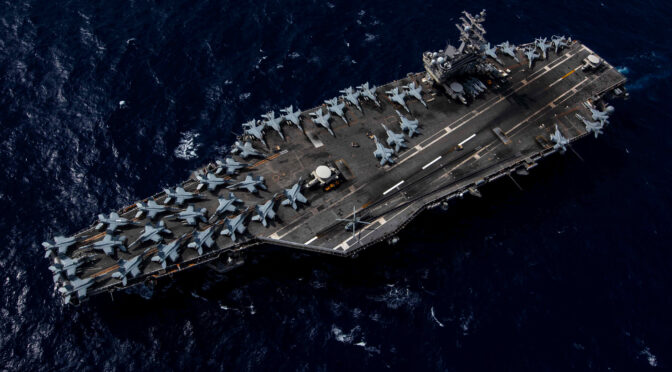
Loading an F-18 with 12 AIMs rather than 4 ASM does cater to one of the fighter’s strengths, but all of this still points to an airwing that needs range and endurance that is lacking. We also need to acknowledge that we are talking about the need for real carrier strike groups again. 2 minimally, ideally at least 3 carriers moving together. We either need to increase CVN production or move LHA production into a more CVL-like ship.
Amen!
The section on air defence is particularly worth reading as it seems too many people seem to think that the carrier is for launching strikes whilst the rest of the the group defend her.
Current events in the Red Sea demonstrate the value of aircraft that can deal with threats at the greatest possible range and with multiple AAMs:
https://www.twz.com/air/super-hornets-now-flying-with-nine-air-to-air-missiles-to-counter-houthi-drones
Note the term magazine depth.
Many of the same points are made in this 1977 Royal Navy training film that can be film in the IWM Collections: PRINCIPLES OF ANTI AIR WARFARE
https://www.iwm.org.uk/collections/item/object/1060029325
I have tried to highlight these issues in a discussion thread about the role of the carrier in Sea Control:
https://www.arrse.co.uk/community/threads/1977-us-congress-report-the-us-sea-control-mission-carriers-needed-in-the-atlantic-for-air-defence-and-asw-due-to-maths-physics-geography.301236/